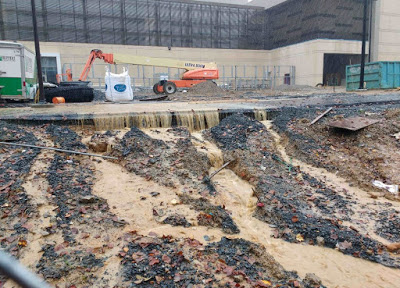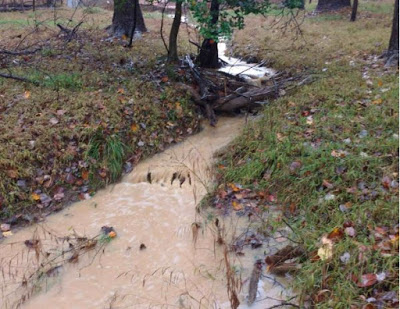Sediment from Inova project is damaging the watershed
 |
| Sediment from the Inova construction site is flowing into streams. [Photos by Kris Unger] |
Construction at the Inova Center for Personalized Health and related projects on Gallows Road on the former Exxon Mobil site is causing large amounts of sediment to flow into streams and is thus compromising the Holmes Run watershed.
While some efforts have been made to correct the problem, it’s not clear whether that is sufficient or whether there is any accountability for Inova or its construction crews.
 |
| Wildlife on the Inova site depend on clean streams. |
Kris Unger, an environmental activist and member of Friends of Accotink Creek (FACC) discovered the problem Oct. 6, when he saw dirty, blackish gray water flowing out of a culvert while taking a walk on the Inova site.
He reported the problem to the Virginia Department of Environmental Quality hotline. The Fairfax County Fire Department arrived within two hours but they didn’t think there was a problem.
Unger also complained to Fairfax County. David Humphrey, a supervising engineering inspector with the Fairfax County Site Development and Inspection Division, sent an email to Unger Oct. 25 stating that several corrective measures had been undertaken, including the removal of silt build-up, the installation of a silt fence and dams, temporary stabilization of the area over the outfall pipe, and landscaping.
However, when Unger visited the construction site on Nov. 3, he found “clear signs of inadequate or overwhelmed sediment control measures and fresh deposits of sediment runoff,” and again reported the problem to state and county officials, noting, “this is after the site had been reported, inspected, and fixed.”
Three days later, Unger and other members of FACC visited the property during a rainstorm and documented large amounts of sediment being washed off the construction site into a tributary of Holmes Run.
H. Keith Anthony, an engineering inspector with the Site Development and Inspection Division, responded Nov. 8, stating a rock berm had been installed across the entire width of the outfall channel to absorb the brunt of the runoff and that an additional silt fence and sodding would be installed.
It’s not known whether the project is in compliance, whether the initial design was adequate, whether there is adequate oversight, and whether there are any penalties or consequences for those responsible, Unger says.
If the county insists the problem has been fixed, he questions whether its definition of compliance is adequate. “Is what they’re doing good enough to protect the watershed?”
 |
| Corrective actions don’t seem to be doing job. |
Many trees were cut down last spring, which is exacerbating the runoff, he says, and whatever has been done since then to control stormwater is not as good as if they had left more trees on the property. The main thing that would move toward permanent stabilization, such as putting down turf to absorb runoff, hasn’t been done.
That property had been undisturbed for years, allowing wildlife to flourish, including deer and foxes, Unger notes. A healthy stream free of sediment is really important to ensure biodiversity. FACC does a lot of stewardship activities, to reduce stormwater runoff, but “the work we do is completely dwarfed by something like this.”
“Inova is focused on health, and the health benefits of nature are obvious, he says. Patients at the new cancer facility under construction “would benefit from having nature nearby, and Inova can be an excellent steward of nature.”
He blames Inova and its construction contractors for destroying the watershed “without anyone really noticing and without any serious consequences.”
Unger believes that if he hadn’t complained to public officials about the runoff, no one would have done anything. Sediment has probably been dumped into Holmes Run for months before the problem was reported.
“I shouldn’t have needed to observe that site,” he says. And FACC, an all-volunteer organization, “is not in a position to judge a multimillion-dollar construction project.”


Sad that such a situation can persist even when the problems are identified to proper authorities. Common sense – it does not take a 'rocket scientist" to see that the situation shown in the pictures is bad and needs to be prevented from recurring?
There not kidding when they call us the dump.
Tree Action Plan
The Tree Action Plan is a 20-year strategy for conservation and management of the county's tree resources. The Tree Action Plan was developed using a collaborative process that involved the Tree Commission, county staff, residents and builders. In June of 2007, the board of supervisors formally adopted a 30-year tree canopy goal based on the recommendations in the Tree Action Plan. The goal is to increase Fairfax County's tree cover to 45% by the year 2037. For more information, see the Tree Action Plan or contact the Urban Forest Management Division at 703-324-1770, TTY 711 or by e-mail.
As recommended in the Tree Action Plan, the Board of Supervisors initiated a countywide tree planting program to improve our air and water quality, and to achieve objectives of the board’s environmental agenda. To support the tree planting program, the board established the Tree Preservation and Planting Fund as a mechanism to administer tree-related donations and funding identified in the annual Environmental Improvement Program. Nonprofit organizations, county agencies and regional governmental agencies may request funding for tree-related projects using the Tree Preservation and Planting Fund Disbursement Procedure.
Tree Action Plan Goals
Commit to conserve current tree assets.
Enhance the legacy for future generations.
Increase the effectiveness of urban forestry with planning and policymaking.
Tree Action Plan Core Recommendations
Engage and educate.
Build strong partnerships and alliances.
Optimize tree conservation in county policies.
Improve air quality and address climate change through tree conservation.
Improve water quality and stormwater management through tree conservation.
Use ecosystem management to improve and sustain the health and diversity of our urban forest.
Strengthen state-enabling authority for tree conservation.
Encourage sustainable design practices.
Plant and protect trees by streams, streets and trails.
Optimize tree conservation in land development.
Optimize tree conservation in utility and public facilities projects.
Support and refine the county's urban forestry programs.
Long Term Threats to the Health of our Forest
Native forest tracts preserved after land development need managing in order to survive and provide maximum benefits.
Zoning required landscaping is maturing and needs proactive management.
Screening and parking lot landscaping ordinances need updating.
Additional tree cover will be lost due to infill and redevelopment.
Effects of urbanized environment on trees.
Introduction and damage caused by exotic forest pests, such as emerald ash borer and Asian longhorned beetle.
Expansion of public roads, highways and other transportation corridors.
Continual fragmentation of forested tracts to facilitate installation, expansion and maintenance of utilities and other infrastructure.
Development and expansion of governmental facilities.
Development and expansion of active recreational facilities such as athletic fields.
Tree removal in residential areas brought about by differing cultural values.
Continual introduction and proliferation of invasive plant species.
Degradation of native forests by unmanaged deer populations.
Disposal of yard debris and household chemicals.
Turfgrass expansion, forest understory clearing and other human-related impacts.
Impacts of climate change on tree species and other organisms that inhabit forest ecosystems.
Still nothing about protecting our mature trees. Every fall and spring these tree choppers solicit the elderly and newly arrived immigrants, who don't know any better to cut down or broccoli head their trees. They use scare tactics to convince the ignorant while they spoil the micro environment. The County should license these tree cutters and train them or run them back to West Virginia.
Serious problem, but we can all briefly chuckle at the irony of the situation: The previous custodian of that land was Exxon Mobile, and they left it pristine. Haha!
But remember, INOVA has plans for lots of development at that site, this is just their first parking lot and it shows already they aren't good stewards of the environment. They should be working with the community on stewardship efforts, restoration of deer browsed understory and keeping the mature tree canopy. It is obvious they could care less.
No; we need more development and more parking lots and more concrete and brick and fewer of those annoying trees and grass and so on, because hey–what could go wrong? This could never happen again! /s
–kda
How in the blazes is a NON-PROFIT hospital group suddenly a real estate developer? How did this happen?
Their architectural engineering firm (I think HDR) that claim to be sustainability and healthcare experts should be fired for not watching the situation and informing their client of these poor construction methods and unsustainable enviormental conditions.
This BoS as to what you all reference Board of Supervisors, is more like the Board of Stupids. Do these 9 BoSs govern anything or are them more like fake government. I've only lived here a short time, but from what I can see is that your Board of Stupids(no I mean Board of S–t needs to be flushed down the toilet. Ok I take that back, that would really hurt the environment.
I'd like to know how that contractor went to work every day thinking this was ok with all the rain we had over the summer. And how long would this have gone on before an inspector stopped by to take a look? Where is the enforcement here?
Friends of Accotink Creek is a great organization and folks like Kris Unger and Philil Latasa are true community heroes being strong advocates for the protection of the watershed. But they can only do so much. They need more volunteers willing to just go out and look at what is going on in the Accotink Watershed. Just an hour a week to go out and take a look and let them know what you found – even if nothing … goes a long way. Consider becoming a Friend of either Accotink Creek or Lake Accotink Park.
Unfortunately, the environment has been secondary to unregulated growth in the County for years. While the green space rapidly disappears, the BOS congratulates themselves on their environmental awareness. Political posturing at its worst!.
The only thing that these BoS relics are interested in is their retirement plans.